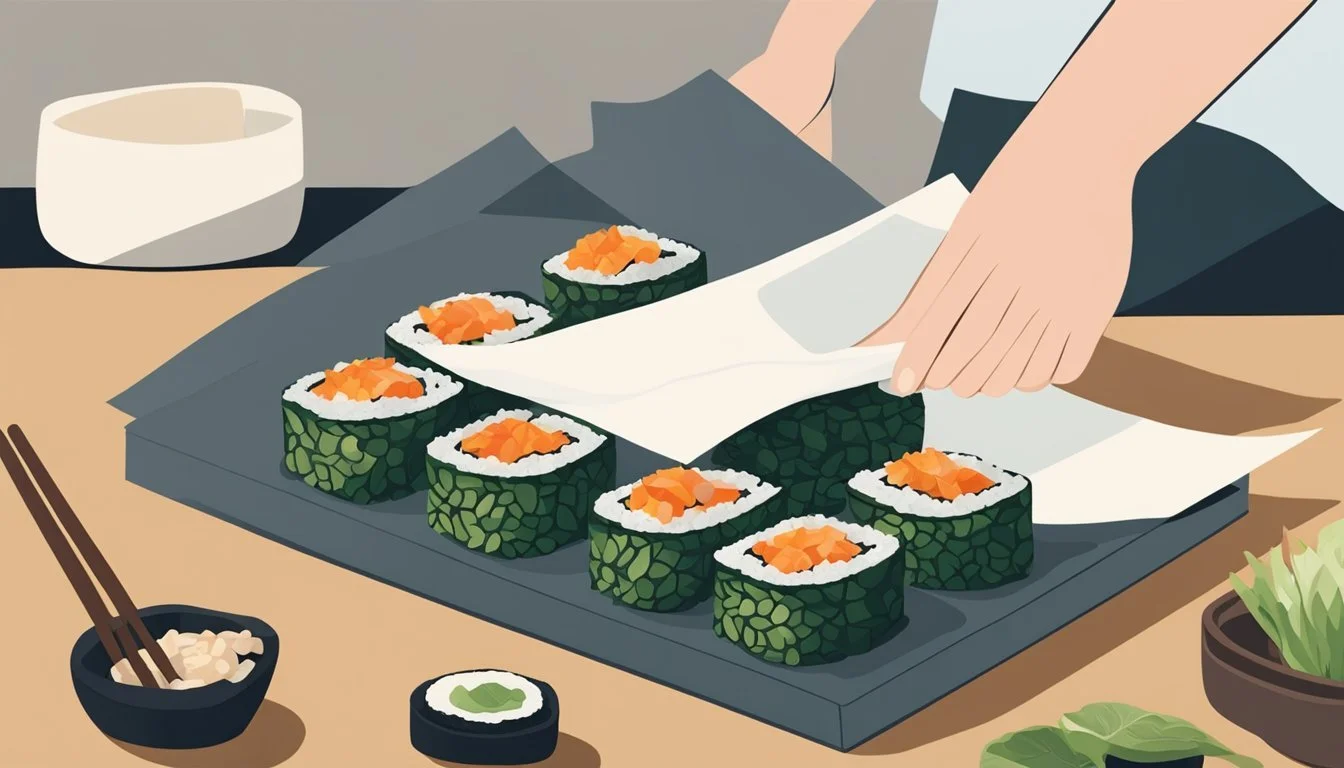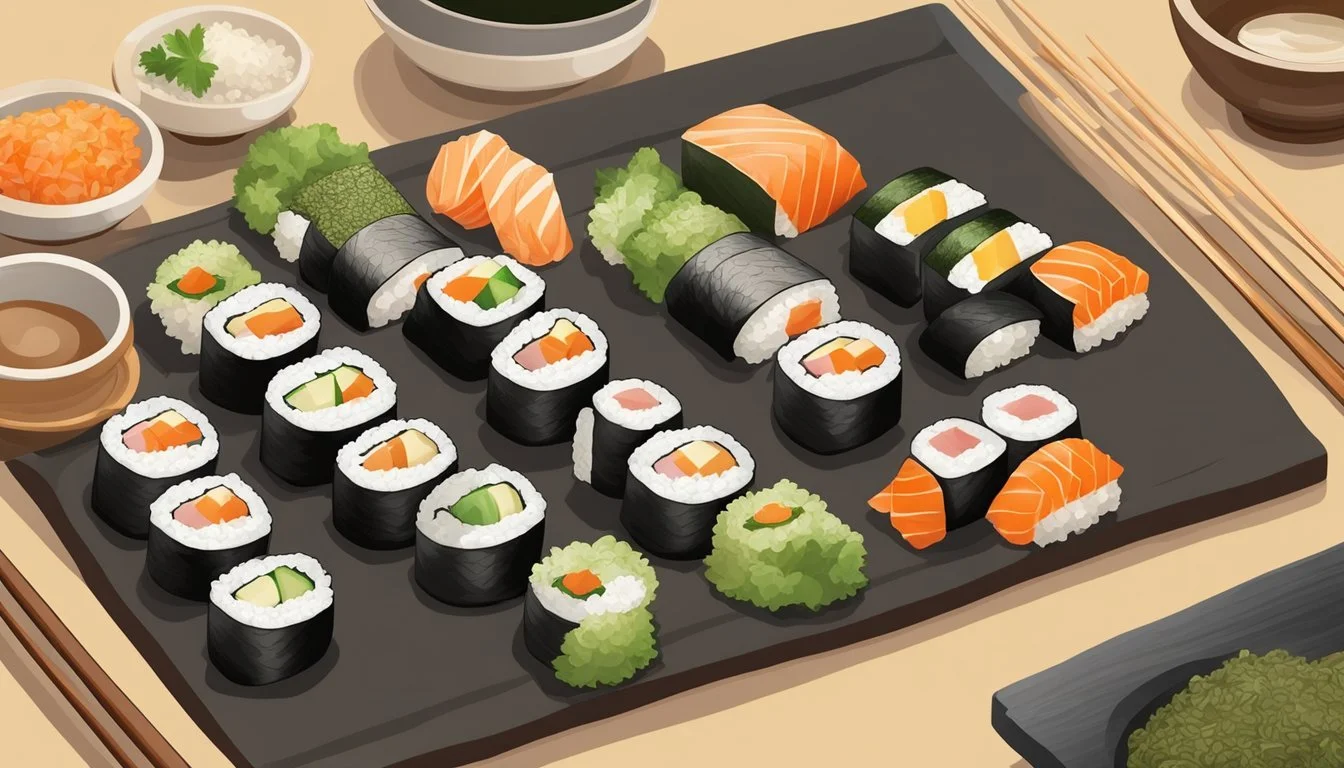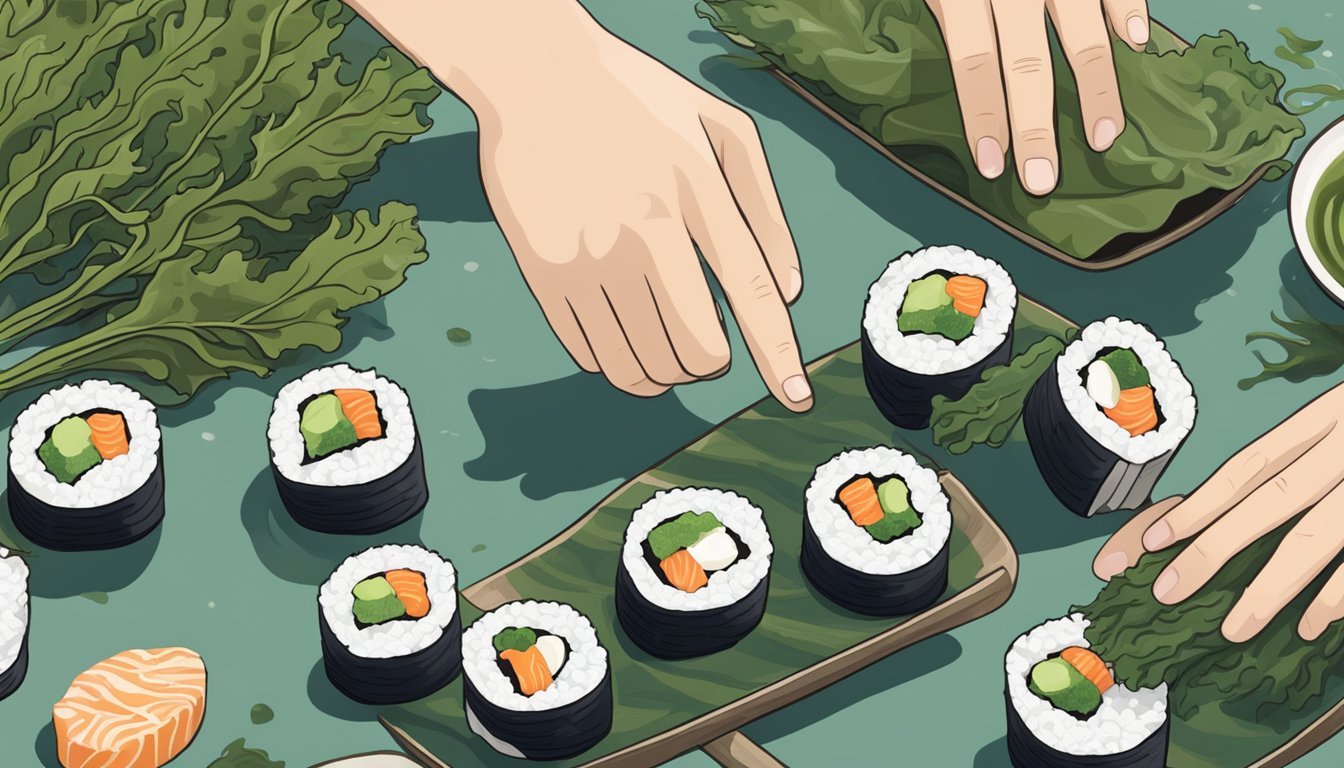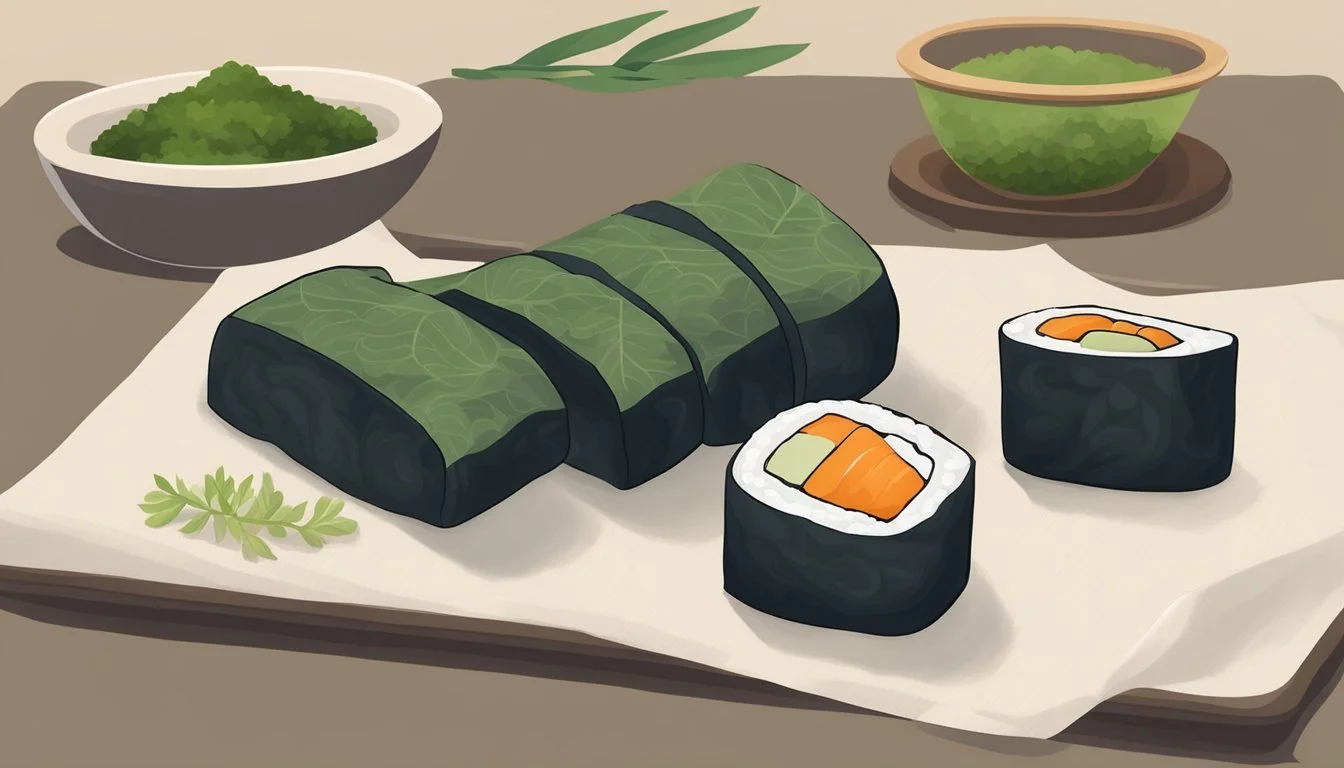How to Substitute Nori Sheets for Kelp in Sushi
Expert Tips for Seamless Swaps
Sushi (What wine goes well with sushi?) enthusiasts often consider nori sheets an essential ingredient for creating the perfect roll. Nori, made from dried seaweed, provides a distinct flavor and holds the sushi ingredients together seamlessly. However, not everyone prefers the taste of nori, or sometimes it may not be readily available. In such cases, kelp emerges as a viable alternative. Kelp, another type of seaweed, can be used to bring a similar texture and oceanic flavor to sushi dishes.
When substituting nori sheets with kelp in sushi, it's important to understand the characteristics that make kelp a suitable replacement. Kelp tends to be thicker and more robust than nori, which can influence the texture and the rolling process of sushi. Additionally, kelp's flavor profile is different, often described as more intense with a briny depth compared to the milder taste of nori.
To ensure a successful substitution, chefs need to prepare kelp properly, often softening it to mimic the pliability of nori sheets. They might use it in the form of kelp wraps or creatively incorporate it into the dish to complement the sushi rice and fillings. This adaptability proves the versatility of seaweeds in the culinary realm and offers sushi lovers an opportunity to explore new flavors and textures while enjoying their favorite dishes.
Understanding Nori and Its Role in Sushi
In sushi preparation, nori is more than a simple ingredient; it has a rich history, distinct nutritional benefits, and imparts unique sensory qualities to the final dish. Let's explore the significant aspects of nori sheets in sushi.
History of Nori in Japanese Cuisine
Nori has played a crucial role in Japanese cuisine for centuries. Initially, it was scraped from dock pilings, washed, and sun-dried during the Edo period. The process was refined into the sheet form recognized today in the late 1600s, becoming an integral part of traditional Japanese culinary practices, especially in sushi.
Nutritional Profile of Nori
Nori sheets are celebrated for their nutritional value, being low in calories while rich in vital vitamins and minerals. Key nutrients in nori include:
Iodine: Essential for thyroid function
Vitamin A: Important for vision and the immune system
Proteins: Contribute to muscle development and repair
Nutrient Benefit Iodine Supports thyroid health Vitamin A Enhances vision and immunity Protein Aids in muscle development
Sensory Qualities of Nori Sheets
The sensory experience of nori is multifaceted:
Flavor: Nori provides an umami taste, a savory depth that enhances other flavors in sushi.
Texture: Its crisp nature adds a contrasting texture alongside the softness of sushi rice and the fillings.
Appearance: The shiny, dark green surface of nori adds visual appeal to sushi, making it as much a treat for the eyes as for the palate.
Exploring Kelp as a Nori Substitute
In the quest for alternative sushi wrappings, one turns to kelp, a versatile seaweed with distinct characteristics and culinary uses that can stand in for nori sheets.
Comparing Kelp and Nori Characteristics
Nori, widely known for its role in sushi preparation, is a type of seaweed that is processed into thin, dried sheets. It has a dark, nearly black color and a subtle, salty flavor with a crisp texture prepping it as an ideal wrap for sushi.
In contrast, kelp pertains to various large seaweeds, of which kombu is a prime example used in Japanese cuisine. Kelp exhibits a thicker, more substantial texture than nori and often comes in wider, longer forms. The flavor profile of kelp is more pronounced; it carries a stronger, umami-rich taste, due to higher levels of natural glutamates. Comparatively, the texture of kelp can be more dense and chewy, requiring proper preparation to make it more palatable as a sushi wrap.
Feature Nori Kelp Texture Crisp, easy to bite through Thick, chewy Flavor Subtle, salty Strong, umami-rich Color Dark green to black Brown to olive green Preparation Ready to use as sheets May require softening
Kelp Varieties and Their Culinary Uses
There are several kelp varieties that are used in the kitchen. Kombu is a type of kelp commonly used to make broths and soups, providing a savory depth of flavor. It's central to dashi, the backbone of Japanese cuisine. When used as a nori substitute, kombu can be softened and cut into sheets for rolling sushi.
Another variety, wakame, is a tender, green kelp often found in miso soup and salads. Though wakame is less likely to serve as a direct substitute for nori due to its different structure, it can still offer a similar flavor profile when included as an ingredient in sushi.
Hijiki, known for its stronger flavor and thicker texture, is another kelp that's usually hydrated before use. While not typically used as a sushi wrap, hijiki can contribute a robust, oceanic flavor to the sushi rice or filling, enhancing the overall taste experience.
In their culinary applications, these kelp varieties provide a range of flavors and textures that can complement the traditional sushi experience:
Kombu: Soften, cut into sheets for sushi rolls
Wakame: Usually in soups and salads but can enhance sushi's flavor
Hijiki: Strong flavor, best as a flavor addition to rice or fillings
How to Prepare Kelp for Sushi
When considering kelp as a substitute for nori in sushi, it is crucial to select the appropriate type of kelp and prepare it correctly to ensure the sushi retains its traditional look and taste.
Selecting the Right Type of Kelp
The key to a successful kelp sushi wrap lies in choosing the right type of kelp. Kombu is the most suitable variety for sushi, known for its thick, leathery texture and rich flavor. One should look for kelp that is dark green or brown with a smooth, shiny surface, indicating freshness and quality.
Preparing Kelp Sheets for Sushi Rolling
The preparation of kelp for sushi rolling involves a few detailed steps to soften the kelp and enhance its flavor:
Cleaning: Gently wipe the surface of the kelp with a damp cloth to remove any dirt or debris. Avoid rinsing kelp under water as it can wash away its natural flavors.
Soaking: Soak the kelp in warm water until it becomes pliable, which can take about 10 minutes. This process also helps to remove some of its saltiness.
Rinsing: After soaking, briefly rinse the kelp under cold water to remove excess salts.
Seasoning: Brush the kelp sheets lightly with rice vinegar mixed with a small amount of sugar to balance the vinegar's acidity. This adds a subtle sweetness and a slight tang, enhancing the sushi's overall flavor profile.
Cutting: Trim the kelp into sheets similar in size to nori, which typically measure about 7 inches by 8 inches.
The prepared kelp sheets are now ready to be layered with seasoned sushi rice and preferred fillings, rolled tightly, and served. One must ensure the rice is well-seasoned with rice vinegar, sugar, and salt to mimic the traditional sushi rice taste.
Innovative Sushi Recipes Using Kelp
Kelp serves as a versatile and nutritious alternative to nori sheets in sushi preparations. It brings a unique texture and taste to the table that can elevate traditional sushi recipes.
Kelp-Wrapped Sushi Rolls
When making sushi rolls, one can substitute nori sheets with thin sheets of kelp. To achieve a balanced flavor and maintain the classic sushi roll structure, it is important to prepare the kelp properly by softening it so that it becomes pliable enough to roll. Kelp-wrapped sushi rolls can be filled with a variety of ingredients such as sushi-grade fish (tuna (What wine goes well with tuna?) or salmon), thinly sliced vegetables (cucumber, avocado, bell peppers), and seasoned rice. They can be served with wasabi and soy sauce for a complete experience.
Ingredients:
Sushi-grade fish: salmon, tuna
Thinly sliced vegetables: cucumber, avocado
Seasoned sushi rice
Kelp sheets
Preparation:
Soften the kelp sheets in warm water.
Lay the softened kelp flat on a bamboo mat covered with plastic wrap.
Spread an even layer of seasoned sushi rice over the kelp.
Add the fish and vegetables in a line along one edge of the rice-covered kelp.
Roll tightly using the bamboo mat, then slice with a sharp knife.
Kelp in Nigiri and Sashimi
Nigiri and sashimi are often presented without any seaweed, but kelp can be used as a base or garnish in these dishes for an innovative twist. For nigiri, a thin strip of kelp under the slice of fish can add a hint of umami and complexity to the palate. It pairs well with the delicacy of the rice and fish, creating a new textural component. Sashimi can be presented on small beds of kelp or served with kelp on the side as a complement to the inherent flavors of the fresh fish.
Ingredients for Nigiri:
Sushi-grade fish: salmon, tuna
Seasoned sushi rice
Kelp strips
Ingredients for Sashimi:
Sushi-grade fish
Kelp
Preparation for Nigiri:
Shape the seasoned sushi rice into small oblong mounds.
Place a thin strip of kelp on top of the rice.
Gently press a slice of fish on top of the kelp.
Preparation for Sashimi:
Arrange thin slices of fresh fish on a serving plate.
Accent with small beds or strips of kelp alongside the fish.
Alternatives to Nori Sheets in Sushi and Cuisine
With an increasing demand for alternative and versatile ingredients, especially in the preparation of sushi and other Japanese cuisine, there are a range of substitutions that can be used instead of nori sheets. These substitutions are aimed at not only maintaining the structural integrity of sushi rolls but also at offering varied textures and flavors.
Vegetable Wraps and Substitutes
Vegetables provide a fresh, crisp option for wrapping sushi rolls. Two common choices are:
Cucumber wraps: These are thin slices of cucumber that can be used to encase sushi ingredients, offering a hydrating crunch.
Lettuce: A more delicate option, lettuce leaves can wrap ingredients softly and are perfect for those seeking a lighter alternative.
Another plant-based option is rice paper, typically used in Vietnamese cuisine for spring rolls. It is a pliable and just-as-effective wrap once moistened. Soy wraps come in a variety of colors and flavors and can replace nori sheets to cater to those with soy preferences or allergies.
Tofu-Based and Specialty Wraps
Tofu products, too, are excellent nori substitutes, providing both flavor and texture. They include:
Inari sushi: This type of sushi uses thin layers of deep-fried tofu called tofu skin or yuba. It is a flexible and durable wrap that absorbs flavors well.
Egg: Whisked and cooked thinly to create a pliable omelet, egg can be used as a wrap for sushi, adding a rich taste and contrasting texture.
Additionally, Korean cuisine offers gim (also known as laver), which is similar to nori and can be used interchangeably in recipes. It contributes a distinct, savory umami flavor to dishes. Each of these alternatives not only provides versatility in sushi making but also enriches the dish with unique tastes and textures.
Sushi Making Techniques Without Nori
When choosing to forgo nori, one can still craft exquisite sushi using alternative methods that focus on hand-shaping techniques or utilizing molds and bamboo mats to create the perfect roll or shape.
Hand-Shaping Techniques for Sushi Without Sheets
One can employ hand-shaping techniques to create sushi varieties such as nigiri or onigiri. Nigiri involves a slice of fresh fish pressed atop a segment of vinegared sushi rice. The chef’s hands are essential in gently molding the rice into an oblong shape that supports the fish. A dab of wasabi between the rice and fish can be added for flavor.
Onigiri, or rice balls, offers a simpler, seaweed-free option. These are balls or triangles of sushi rice commonly filled with pickled umeboshi, salted salmon, or similar fillings. To shape them:
Wet hands: Keep a bowl of water to prevent rice from sticking.
Rice base: Place a small amount of sushi rice in the palm.
Fillings: Add the selected filling to the center of the rice.
Shape: Mold rice into a ball or triangular shape using both hands.
Toppings (optional): Roll the onigiri in toasted sesame seeds or wrap it in a thin omelette strip.
Using Molds and Bamboo Mats for Sushi
For those keen on replicating the roll structure of sushi without the traditional nori, rice, and fillings can be arranged in a dedicated sushi mold or on a bamboo mat with a plastic wrap.
Using a sushi mold:
Fill mold base: Press sushi rice firmly into the mold to form the bottom layer.
Fillings: Layer ingredients like cucumber, bell peppers, avocado, or sashimi-grade fish.
Top layer: Add another layer of rice on top and press down.
Release: Open the mold to reveal a formed sushi rice dish ready to be sliced.
Utilizing a bamboo mat:
Plastic layer: A plastic sheet is placed over the bamboo mat to prevent sticking.
Rice layer: Spread a layer of sushi rice on the plastic.
Ingredients: Arrange your choice of fillings along the rice surface.
Rolling: Lift the end of the mat, gently rolling the layered ingredients into a sushi roll shape.
Firming up: Apply gentle pressure to define the roll’s shape.
Slicing: Unwrap and slice the roll with a sharp, wet knife into bite-sized pieces.
By employing these methods, sushi enthusiasts can enjoy the experience and flavors of sushi without the inclusion of nori sheets, using either the dexterity of their hands or the assistance of a mold and bamboo mat.
Pairing and Serving Suggestions
When substituting kelp for nori in sushi, the pairing of condiments, garnishes, and side dishes can enhance the flavors and complement the earthiness of kelp. Careful selection ensures a harmonious sushi dining experience.
Condiments and Garnishes for Kelp Sushi
Condiments:
Soy Sauce: A staple with sushi, it provides a salty umami flavor that pairs well with the sea-infused taste of kelp.
Wasabi: Offers a sharp, pungent complement to the subtle oceanic flavor of kelp-wrapped sushi.
Pickled Ginger: Cleanses the palate between different sushi pieces.
Garnishes:
Sesame Seeds: Toasted for a nutty crunch.
Furikake: A mixture of dried fish, sesame seeds, and chopped seaweed sprinkled on top for added flavor complexity.
Shiso Leaves: Their minty taste can provide a fresh contrast to the succulence of kelp.
Side Dishes Complementing Kelp Sushi
Soups and Salads:
Miso Soup: Balances the meal with its warm, savory broth.
Seaweed Salad: A side dish containing various types of seaweed, offering a textural variety alongside kelp sushi.
Green Salad: Dressed lightly, it adds a crisp element, making it a refreshing counterpoint to the richness of sushi.
Serving Suggestions:
Kelp Sushi should ideally be accompanied by side dishes that don't overpower its unique flavor. Light soups, such as a clear broth or miso soup, and simple salads work well.
Health Considerations and Dietary Restrictions
When substituting nori sheets with kelp in sushi, individuals must consider potential allergens, nutritional content, and how these factors align with dietary restrictions.
Understanding Potential Allergens and Contaminants
Allergens: Some individuals might be allergic to various types of seaweed, including kelp. Symptoms can range from mild to severe and can include itching, swelling, and difficulty breathing. It is crucial for these individuals to consult with a healthcare provider before consuming new types of seaweed.
Iodine: Kelp contains high levels of iodine, which is essential for thyroid function but can be detrimental in excessive amounts, especially for those with thyroid conditions.
Arsenic: Edible seaweeds like kelp can accumulate arsenic. While the levels are generally low and considered safe, some people may choose to limit their intake as a precaution.
Nutritional Benefits and Concerns with Seaweed
Nutritional Profile of Kelp:
Iodine: Beneficial for thyroid health in appropriate quantities.
Calcium: Important for bone health.
Nutrients: Kelp is rich in various vitamins and minerals, contributing positively to one's overall nutrient intake.
Dietary Restrictions:
Gluten-Free: Kelp is naturally gluten-free, making it suitable for those with celiac disease or gluten sensitivity.
Vegetarian and Vegan: Kelp is a plant-based source of nutrients, fitting into vegetarian and vegan diets.
Individuals seeking to replace nori with kelp should carefully consider these factors and may find many health benefits if consumed in moderation. Kelp can often be found in local grocery stores, typically in the international or health food sections.
Shopping Guide for Nori and Kelp
When searching for seaweed products like nori and kelp, particularly for Japanese cuisine, consumers should be attentive to quality and freshness. These are vital factors that can greatly influence the taste and texture of the final dish.
Finding Seaweed at Local and International Markets
One can find nori and kelp at local grocery stores, especially those with a section dedicated to international or Asian foods. For a broader selection, shoppers should consider visiting markets that specialize in Japanese cuisine. These often stock higher quality seaweed products because they cater to a clientele that is knowledgeable about these ingredients. When shopping, it is recommended to:
Look for stores with high product turnover to ensure the freshness of seaweed.
Check for international markets or specialty stores within the vicinity, as they may carry a wider variety of both nori and kelp.
Selecting Quality Sea Vegetables
Regarding quality, there are a few indicators a buyer should look for:
Packaging: It should be airtight to preserve freshness and prevent moisture – the enemy of dried seaweed products – from seeping in.
Appearance: Quality nori should have a uniform, dark-green to black color, while kelp should be free from excessive whitish spots or discolorations.
Labels: Higher-grade nori is often labeled as "Gold" or "Silver", indicating its suitability for sushi due to its superior texture and taste.
For freshness:
Nori should have a crisp texture that cracks easily, not chewy or brittle.
Kelp, though thicker, should not show signs of excessive drying or brittleness.
When considering these points, shoppers will be better positioned to select high-quality nori and kelp for their sushi-making endeavors.
Conclusion
Substituting nori with kelp in sushi introduces a unique culinary twist to the traditional Japanese dish. Kelp, with its distinct flavor and texture, emerges as a commendable substitute, allowing for both variety and innovation. One finds that the use of kelp may appeal to those seeking a milder taste compared to nori's more pronounced marine profile.
In terms of preparation, chefs must handle kelp with an understanding of its textural variability to achieve the optimal sushi wrap. It is advised to ply the kelp to a pliable state before forming rolls to ensure ease of sushi construction. When dealt with attentively, kelp can serve as both a functional and flavorful stand-in for nori.
Culinary Creativity: The integration of kelp extends sushi's boundaries, inviting culinary creativity while still honoring the dish's essence.
Here are a few key points to remember about kelp as a nori substitute:
Flavor: Kelp has a subtler sea taste which can be preferable for some palates.
Texture: When softened, kelp's texture provides a satisfactory bite similar to that of nori.
Nutritional Value: As a seaweed, kelp is rich in minerals and vitamins, contributing to the nutritious profile of sushi.
Those who tackle sushi-making with an open mindset and kelp in hand may uncover a delightful variation to traditional techniques. This ingredient swap champions the spirit of culinary exploration without compromising the integrity of the beloved sushi experience.








